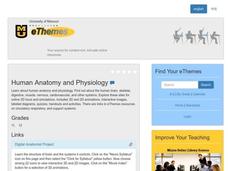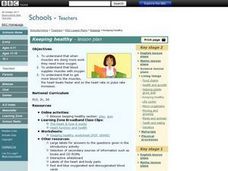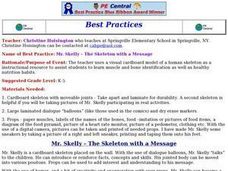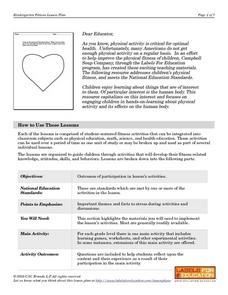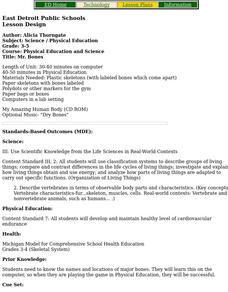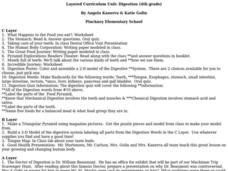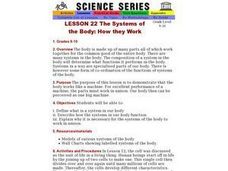IBM
The Human Body
Every moment, the systems in your body are working together to keep you breathing, standing, and thinking. Elementary schoolers explore the human body and its systems with an impressive, 15-page lesson plan that should leave your...
Curated OER
Exercise and Muscles
Eighth graders identify and label the primary and secondary muscles used to perform an exercise. Students perform an exercise on a weight machine to figure out which muscles are being used. Students illustrate the muscles used by...
Curated OER
Natural Born Robots: Body Builders
Students perform activities to explore how their arm works and what muscles are involved. They view animated comparisons of human and robotic arms. Students create a model of the human arm.
Common Sense Press
What is the Skeletal System?
Students investigate the human skeletal system. In this biology lesson, students trace the outline of their body onto butcher paper and fill in the names of the bones. Students use an overhead transparency of the human skeletal system to...
Curated OER
Skeleton
Students study the skeleton. In this human body lesson, students draw and label bones in the body by tracing each other and creating a skeleton out of body parts and brass fastners.
Curated OER
Fetal Pig: Circulatory System
Step-by-step instructions for fetal pig dissection and viewing of the circulatory system is given in this exercise. Your young biologists match the names to the organs or label a diagram of the pig circulatory system. This resource is...
Curated OER
Keeping Healthy Lesson Plan
Students explore how muscles work. In this health lesson, students identify how the blood supplies muscles with oxygen. Students participate in an online activity to reinforce the concepts.
Curated OER
Bones and Muscles
Third graders are introduced to bones as the body's means of support and protection. They research bone facts and conduct an experiment with chicken bones. They identify and observe involuntary muscles at work.
Curated OER
Health: The Skeleton with a Message
Students identify human muscles and bones from a cardboard skeleton, named "Mr. Skelly." Using dialog balloons as props, the teacher holds up advice from Mr. Skelly, such as noting he drinks milk to keep his bones strong. The lesson...
Curated OER
What Do We Have In Common?
Seventh graders perform a dissection on a mussels and label their internal organs. In groups, they compare and contrast the mussels structure to those of human beings. They also review the functions that are necessary for survival and...
Curated OER
Change the Beat
Brainstorm the reasons why a healthy heart is important. Using a diagram, label and locate the heart and discuss its function. Practice finding your heartbeat and describe the effects of physical activity on the heart. Also perform an...
Curated OER
Mr. Bones
Students play CD-ROM game My Amazing Human Body, and participate in relay game in Phys. Ed. where they put together skeleton on which body parts are labeled.
Curated OER
Bone Relay
Students reinforce their ability to identify bones of the body in a game setting using a Volleyball net, clothes pins, x-rays or pictures of human bones and joints.
Curated OER
Starvation in the Ghettos
Young scholars investigate how human beings survive under camp and ghetto life's extreme condition while understanding the USRDA requirements. They recognize the suffering and loss of life due to the lack of adequate nutrition.
Curated OER
Digestion
Fourth graders answer the question what happens to the food you eat? They complete a worksheet about the food you eat. They discuss the different types of teeth that we have. Students complete digestion poster in which they color and...
Curated OER
What Does The Heart Do?
Young scholars study the relationship between the heart and circulation. In this circulatory system lesson, students read the "What Am I?" article about the heart and discuss. Young scholars draw a heart and lungs, discover how blood is...
Curated OER
The Systems of the Body: How they Work
Students study what a body system is, how they function and how the systems work in unison.
Curated OER
Cardiovascular System Definitions and Study Questions
In this cardiovascular system study question worksheet, students define 21 words associated with this system. They answer 16 short answer questions related to circulation of blood through the body.
Curated OER
Homology: Where Does The Evidence Lead
Students are introduced to the topic of homology. In groups, they read a case study and compare different drawings of early vertebrate emryos. They work together to answer discussion questions and label the various parts of each embryo.
Curated OER
Chromosomes
Students explore genetics, chromosomes and DNA. In this genetics lesson students design a chromosome and identify a family tree through genetics.
Curated OER
What Can We Learn From Bones?
Students discuss what type of information they can gather from bones. In groups, they travel between stations in which they can view photos and listen to actual accounts of finding bones. They focus on the tools available to Native...
Curated OER
Starvation in the Ghettos
Middle schoolers consider the lack of nutrition experienced in Holocaust ghettos. In this Holocaust instructional activity, students investigate the Nazi policy of starving people out of the ghettos through their food rationing program....




